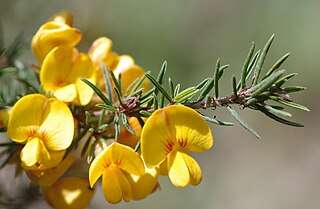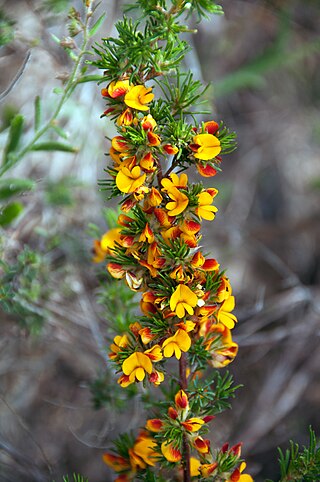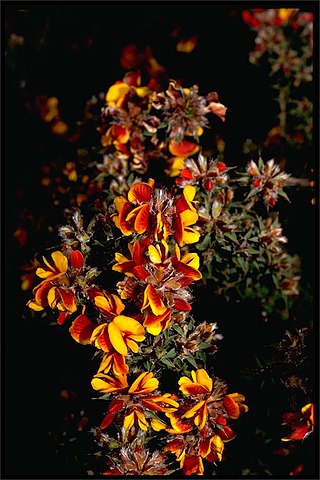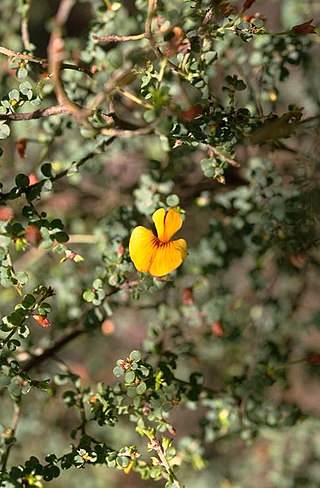
Pultenaea juniperina, commonly known as prickly bush-pea or prickly beauty is a species of flowering plant in the family Fabaceae and is endemic to south-eastern Australia. It is an erect, spiky shrub with hairy stems, linear to narrow elliptic leaves with stipules at the base, and yellow-orange and red flowers.

Pultenaea flexilis known as the graceful bush-pea, is a species of flowering plant in the family Fabaceae and is endemic to eastern Australia. It is an erect shrub with linear to narrow egg-shaped leaves with the narrower end towards the base, and yellow to orange flowers with red markings.

Pultenaea mollis, commonly known as soft bush-pea or guinea flower bush pea, is a species of flowering plant in the family Fabaceae and is endemic to south-eastern Australia. It is an erect or spreading shrub with narrow linear to elliptic or needle-shaped leaves and clusters of up to ten yellow to orange flowers with red markings.

Pultenaea acerosa, commonly known as bristly bush-pea, is a species of flowering plant in the family Fabaceae and is endemic to south-eastern continental Australia. It is a rigid, much-branched shrub with glabrous, grooved, needle-shaped leaves and yellow flowers with red veins.

Pultenaea borea is a species of flowering plant in the family Fabaceae and is endemic to Queensland, Australia. It is an erect shrub with elliptic to linear or egg-shaped leaves and yellow to orange and red flowers.

Pultenaea costata, commonly known as ribbed bush-pea, is a species of flowering plant in the family Fabaceae and is endemic to the Grampians National Park in Victoria. It is a spreading shrub with egg-shaped to lance-shaped leaves, and dense clusters of pea-like flowers.

Pultenaea daltonii, commonly known as hoary bush-pea, is a species of flowering plant in the family Fabaceae and is endemic to western Victoria, Australia. It is a spreading shrub with cylindrical leaves, grooved on the upper surface, and clusters of yellow flowers with red markings.

Pultenaea divaricata is a species of flowering plant in the family Fabaceae and is endemic to a small area of New South Wales. It is an erect shrub with linear, needle-shaped, grooved leaves, and dense clusters of yellow to orange flowers with red markings.

Pultenaea echinula, commonly known as curved bush-pea, is a species of flowering plant in the family Fabaceae and is endemic to a small area of New South Wales. It is an erect shrub with linear, needle-shaped, grooved leaves, and dense clusters of yellow to orange and red flowers.

Pultenaea linophylla, commonly known as halo bush-pea, is a species of flowering plant in the family Fabaceae and is endemic to south-eastern continental Australia. It is an erect or prostrate shrub with spreading branches, linear to elliptic or wedge-shaped leaves, and yellow to orange and red to purple flowers.
Pultenaea maidenii, commonly known as Maiden's bush-pea, is an extinct species of flowering plant in the family Fabaceae and was endemic to Victoria, Australia. It was an erect shrub with egg-shaped leaves with the narrower end towards the base, and pea-shaped flowers.

Pultenaea paleacea, commonly known as chaffy bush-pea, is a species of flowering plant in the family Fabaceae and is endemic to eastern Australia. It is a prostrate to spreading shrub with linear to lance-shaped leaves with the narrower end towards the base, and yellow to orange and red to purple flowers.

Pultenaea patellifolia, commonly known as Mt Byron bush-pea, is a species of flowering plant in the family Fabaceae and is endemic to the Black Range in the Grampians National Park in Victoria. It is a spreading shrub with round leaves, and clusters of yellow and red, pea-like flowers.

Pultenaea penna, commonly known as feather bush-pea, is a species of flowering plant in the family Fabaceae and is endemic to south-eastern continental Australia. It is a rigid, spreading shrub with linear, needle-shaped leaves and yellow and red, pea-like flowers.
Pultenaea prolifera, commonly known as Otway bush-pea, is a species of flowering plant in the family Fabaceae and is endemic to the south coast of Victoria. It is an erect shrub with needle-shaped leaves, and yellow and red pea-like flowers arranged singly in leaf axils on the ends of short side branches.

Pultenaea pycnocephala, commonly known as dense-head bush-pea, is a species of flowering plant in the family Fabaceae and is endemic to eastern Australia. It is an erect shrub with hairy branches, egg-shaped leaves with the narrower end towards the base and yellow to red and purple, pea-like flowers.
Pultenaea robusta is a species of flowering plant in the family Fabaceae and is endemic to eastern Australia. It is an erect shrub with hairy branches, linear leaves, and yellow to orange and red to purple, pea-like flowers.
Pultenaea trichophylla, commonly known as tufted bush-pea, is a species of flowering plant in the family Fabaceae and is endemic to South Australia. It is a slender, prostrate to erect shrub with hairy branchlets, lance-shaped leaves, and yellow to orange and red, pea-like flowers.

Pultenaea viscidula, commonly known as dark bush-pea, is a species of flowering plant in the family Fabaceae and is endemic to South Australia. It is an erect shrub with branches that are sticky when young, linear to cylindrical, channelled leaves with stipules at the base, and yellow to orange and yellow-red to green flowers.

Pultenaea williamsoniana, commonly known as Williamson's bush-pea, is a species of flowering plant in the family Fabaceae and is endemic to a restricted area of Victoria, Australia. It is a slender, erect shrub with its stems covered with white hairs, and has cylindrical, grooved leaves and yellow to orange and red, pea-like flowers arranged in clusters on the ends of short side branches.
















